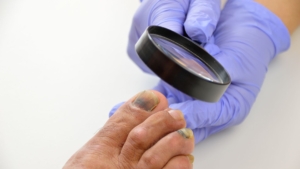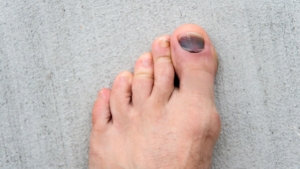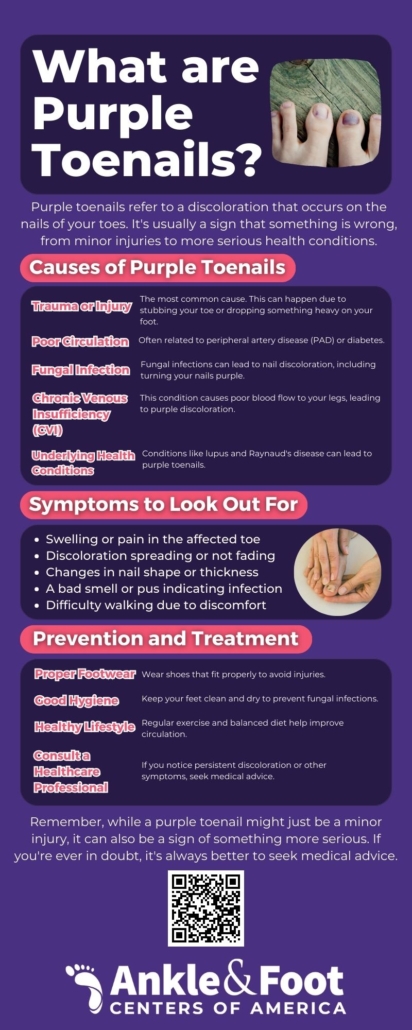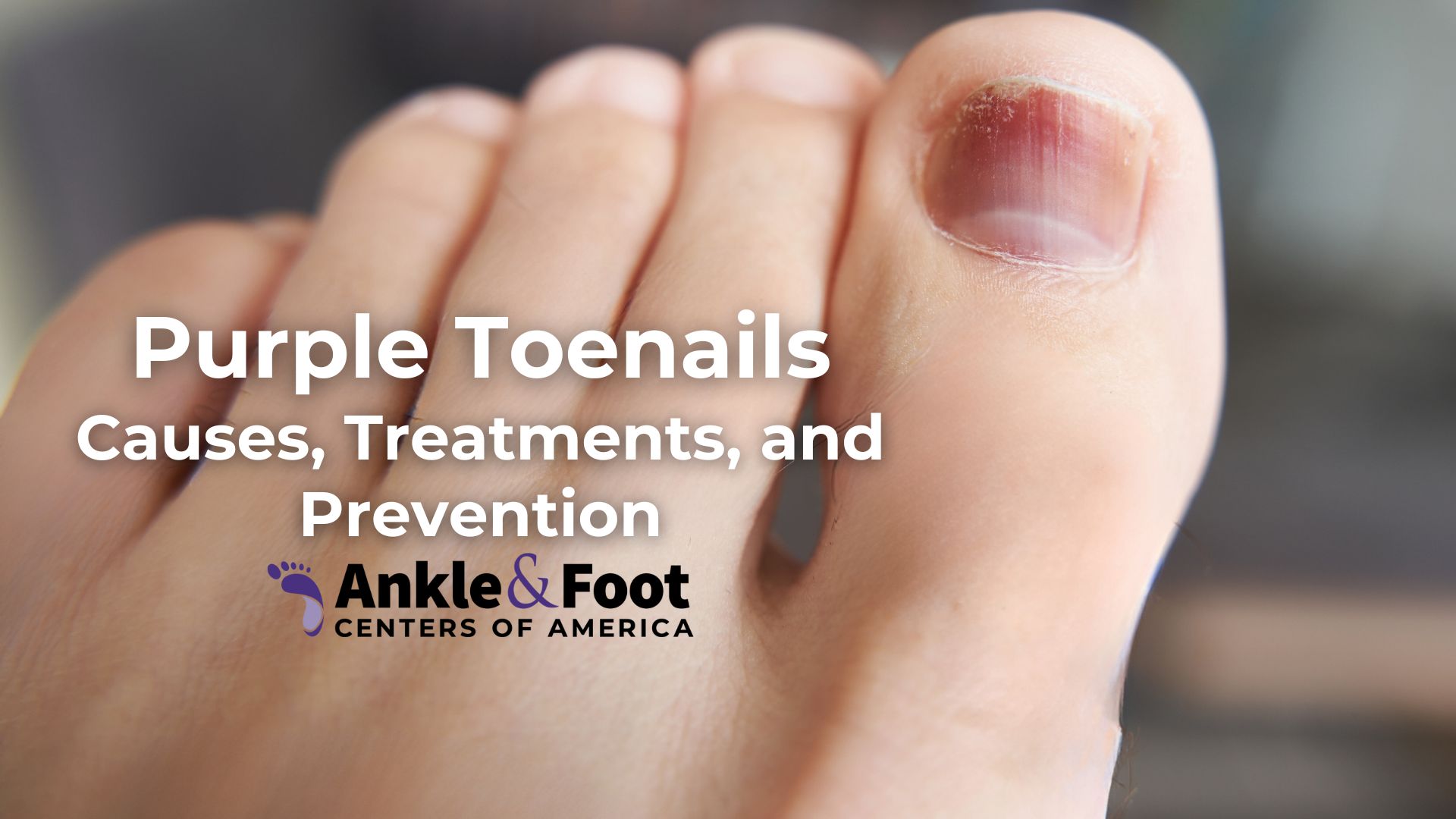The phenomenon of purple toenails, while not uncommon, often arouses curiosity and concern among those who experience it. A sudden change in toenail color can be a shock, making us wonder if it signals a serious health condition. This article aims to demystify the occurrence of purple toenails, outlining their possible causes, treatments, and measures for prevention.
Table of Contents
Causes of Purple Toenails
 Toenails, like other parts of our body, can act as indicators of our overall health.
Toenails, like other parts of our body, can act as indicators of our overall health.
Noticing your toenails turning purple can be disconcerting, but it’s essential to remember that multiple factors could contribute to this change.
The Role of Footwear in causing Purple Toenails
The type of footwear you choose can have a profound impact on your toenails’ health. Shoes that are too tight or don’t fit correctly can compress the toes, leading to bruising or injury that results in a purple color. This is particularly true for high heels or pointed shoes, which push the toes into an unnatural position, increasing the risk of toenail damage.
Furthermore, athletes, especially runners, often experience purple toenails. Running shoes, if not correctly fitted, can cause constant friction against the toenail, leading to a condition known as runner’s toenail or jogger’s toe. This repeated trauma can result in a build-up of blood under the toenail, giving it a purple or black appearance.
Aging and Purple Toenails
Aging is another factor that can contribute to changes in toenail color. As we age, our bodies undergo various transformations, including in our nails. The blood circulation in our extremities, like our toes, can diminish with age, leading to oxygen deprivation in the toenail area. This lack of oxygen can sometimes cause the toenails to appear blue or purple.
Diabetes and Purple Toenails
 If you’re diabetic, you need to be extra attentive towards any changes in your toenails. Diabetes can affect blood circulation, particularly in the lower extremities. This diminished circulation can lead to toenail discoloration, including a purple hue. In some cases, purple toenails in diabetics may also indicate the onset of a more serious condition known as diabetic neuropathy.
If you’re diabetic, you need to be extra attentive towards any changes in your toenails. Diabetes can affect blood circulation, particularly in the lower extremities. This diminished circulation can lead to toenail discoloration, including a purple hue. In some cases, purple toenails in diabetics may also indicate the onset of a more serious condition known as diabetic neuropathy.
Exercise and its effects on Toenail Color
Physical exercise, while essential for maintaining good health, can occasionally lead to purple toenails. This is especially true for activities that put significant stress on the feet, such as running, hiking, or dancing. High-impact exercises can cause trauma to the toenails, leading to a hematoma, or collection of blood under the nail, which appears purple or black. However, this is typically painless and resolves on its own over time.
Runners, in particular, often deal with the phenomenon of purple toenails. This is so common that it even has a name – “runner’s toe.” The repetitive impact of the foot striking the ground can lead to microtrauma in the toenails, causing them to become discolored. Furthermore, downhill running or running on a decline can cause the foot to slide forward in the shoe, leading to additional pressure on the toes.
Selecting properly fitted running shoes and socks, and keeping the toenails trimmed can help alleviate this issue. If you’re a runner and notice your toenails turning purple, it’s important not to ignore this symptom. Although it’s often harmless, recurrent cases can sometimes lead to more serious complications like toenail loss or fungal infection. Therefore, it’s recommended to seek advice from a healthcare professional or a specialty running store to ensure your footwear is not contributing to the problem.
Understanding Toenail Health
Taking a closer look at our toenails can provide valuable insights into our health and wellbeing. They are not just for beautification or protection but can serve as windows into our body’s internal workings.
The Significance of Toenail Color
 Toenail color can range from clear to slightly yellowish, depending on a person’s age, diet, and lifestyle habits. But any drastic change in the natural color of the toenail should be noted, as it could signal a health concern. For instance, yellow toenails may indicate a fungal infection, while white spots could suggest a deficiency in certain vitamins or minerals.
Toenail color can range from clear to slightly yellowish, depending on a person’s age, diet, and lifestyle habits. But any drastic change in the natural color of the toenail should be noted, as it could signal a health concern. For instance, yellow toenails may indicate a fungal infection, while white spots could suggest a deficiency in certain vitamins or minerals.
Purple toenails, on the other hand, are often a sign of a bruise or hematoma due to an injury or pressure. However, they could also indicate a circulation issue, particularly if accompanied by other symptoms like swelling or pain. Therefore, it’s crucial to pay attention to these changes and seek medical advice if necessary.
What a Healthy Toenail Should Look Like
Healthy toenails are usually clear, smooth, and have a consistent color throughout. They should be devoid of any spots, streaks, or discoloration. The nails should also have a certain degree of hardness while maintaining some flexibility.
However, it’s essential to remember that everyone’s toenails are different, and what’s normal for one person might not be for another. Factors such as age, ethnicity, and genetics can all play a role in determining what a ‘healthy’ toenail looks like.
Toenail Color Changes: What do They Mean?
Changes in toenail color are not uncommon and can happen due to various reasons. A greenish tint might suggest a bacterial infection, while white or yellowish nails could point to a fungal condition.
Purple or black toenails are typically due to some form of trauma or injury causing bleeding under the nail. In some cases, though, purple toenails can indicate a vascular issue, such as a vein problem in the lower extremities or Raynaud’s disease.
It’s important to understand that while most toenail color changes are harmless, they can sometimes be a sign of an underlying health issue. So, any persistent discoloration that doesn’t improve over time should be evaluated by a healthcare professional.
Diagnosis of Purple Toenails
If you’ve noticed your toenails turning purple and are concerned, it may be time to seek medical advice.
When to See a Doctor for Purple Toenails
While purple toenails due to injury or pressure often resolve on their own, it’s wise to schedule an appointment with a healthcare provider if the discoloration persists. If the purple color is accompanied by other symptoms like pain, swelling, or changes in the shape or thickness of the nail, it’s crucial to get a medical evaluation.
What to Expect During a Toenail Examination
During a toenail examination, your healthcare provider will first ask about your medical history and any symptoms you’ve experienced. They’ll then physically examine the affected toenail, checking for any signs of injury, infection, or disease.
In some cases, a small sample of the toenail might be taken for lab testing. This can help rule out conditions like fungal infections or psoriasis. The doctor might also order additional tests, like a blood test or a Doppler ultrasound, to check for circulation issues if suspected.
How Purple Toenails are Diagnosed
The diagnosis of purple toenails largely depends on the underlying cause. For example, if the purple color is due to a bruise or hematoma, the diagnosis can often be made based on a physical exam alone. However, if the cause is not apparent, further testing may be needed.
If a circulation problem is suspected, the doctor might conduct a vascular study or order an ultrasound of the lower extremities. This can help assess the blood flow in the feet and detect any potential issues like blood clots or venous insufficiency.
When an infection is a possible cause, the doctor may take a nail scraping or clip a portion of the toenail for laboratory testing. This can help identify any fungi, bacteria, or other pathogens that might be causing the discoloration.

Treatments for Purple Toenails
The treatment for purple toenails will primarily depend on the underlying cause of the discoloration. In many cases, no specific treatment is necessary, and the toenail will return to its normal color once the underlying issue is addressed.
Medical Treatments for Purple Toenails
 Medical treatments might be necessary if an infection or a circulatory disorder is causing the purple toenails. If a bacterial or fungal infection is present, the doctor might prescribe an antibiotic or antifungal medication to clear up the infection. Topical creams or oral medications might also be used.
Medical treatments might be necessary if an infection or a circulatory disorder is causing the purple toenails. If a bacterial or fungal infection is present, the doctor might prescribe an antibiotic or antifungal medication to clear up the infection. Topical creams or oral medications might also be used.
In cases where poor circulation is causing the discoloration, the treatment will focus on improving blood flow to the affected area. This might involve medication to prevent blood clots, or in more severe cases, surgical intervention might be necessary.
It’s important to note that each case is unique, and the treatment for purple toenails n will be personalized based on the individual’s health status and the specific cause of the purple toenails.
Home Remedies for Managing Purple Toenails
If the purple toenails are due to a minor injury or bruise, home remedies can often be effective. These might include:
- Resting and elevating the foot to reduce inflammation.
- Applying a cold compress to the area to alleviate pain.
- Using over-the-counter pain relievers as needed.
Moreover, maintaining good foot hygiene can prevent many toenail issues. This includes washing the feet regularly, drying them thoroughly, and keeping the toenails properly trimmed.
Case Study: Success stories of Purple Toenail Treatment
Take, for instance, the case of Jane, a marathon runner who frequently experienced purple toenails after her long runs. After consulting with her doctor and a specialty running shoe store, Jane switched to a different shoe brand that offered more toe space. She also began using moisture-wicking socks and started applying a protective layer of petroleum jelly on her toes before her runs. Over time, Jane noticed a significant reduction in the frequency of her purple toenails, demonstrating the effectiveness of proper foot care and suitable footwear in managing this issue.
Prevention of Purple Toenails
While it’s not always possible to prevent purple toenails, especially when they’re due to underlying health conditions, there are steps you can take to minimize your risk.
Tips for Preventing Purple Toenails
Proper foot and toenail care is the cornerstone of preventing many common toenail issues, including purple toenails. This includes:
- Keeping your feet clean and dry to prevent infections.
- Trimming your toenails straight across to avoid ingrown toenails.
- Wearing properly fitting shoes that offer enough room for your toes.
- Changing your socks regularly, especially if you sweat excessively.
- Giving your feet some time to ‘breathe’ by going shoeless when possible.
Footwear Choices and their Impact on Toenail Health
The shoes you wear play a significant role in your toenail health. Shoes that are too tight, narrow, or don’t fit properly can cause constant pressure on your toenails, leading to damage and discoloration. When purchasing shoes, it’s important to ensure they offer enough room in the toe area. This is particularly crucial for runners or those involved in high-impact activities.
In summary, purple toenails are often a benign condition resulting from minor trauma or pressure on the toes. However, they can sometimes indicate a more serious underlying issue, such as a circulatory disorder or an infection.

The Psychological Impact of Purple Toenails
While physically harmless in many cases, purple toenails can cause psychological distress for some people, particularly those who are conscious about their appearance. It’s important to remember that our toenails, like all other parts of our body, can undergo changes and that’s perfectly normal. If you’re feeling self-conscious about your purple toenails, talking to a podiatrist can help address your concerns and provide reassurance.
Self-care and its Role in Maintaining Toenail Health
Taking good care of your feet is not just about keeping your toenails looking good. It’s also about maintaining the health of your feet. Regularly inspect your feet for any changes, keep them clean and moisturized, and wear comfortable footwear. All these steps can go a long way in ensuring the health and wellbeing of your feet.
Concluding Thoughts on Purple Toenails
Purple toenails can be a cause for concern, especially if you’re unsure of what’s causing the discoloration. However, by understanding the potential causes and treatments, and by taking proactive steps to care for your feet, you can effectively manage this condition.
Remember, our toenails are more than just aesthetic features on our feet. They’re indicators of our overall health. So, give them the care they deserve and, when in doubt, don’t hesitate to seek professional medical advice. After all, our feet carry us through life, and they deserve to be well taken care of.





